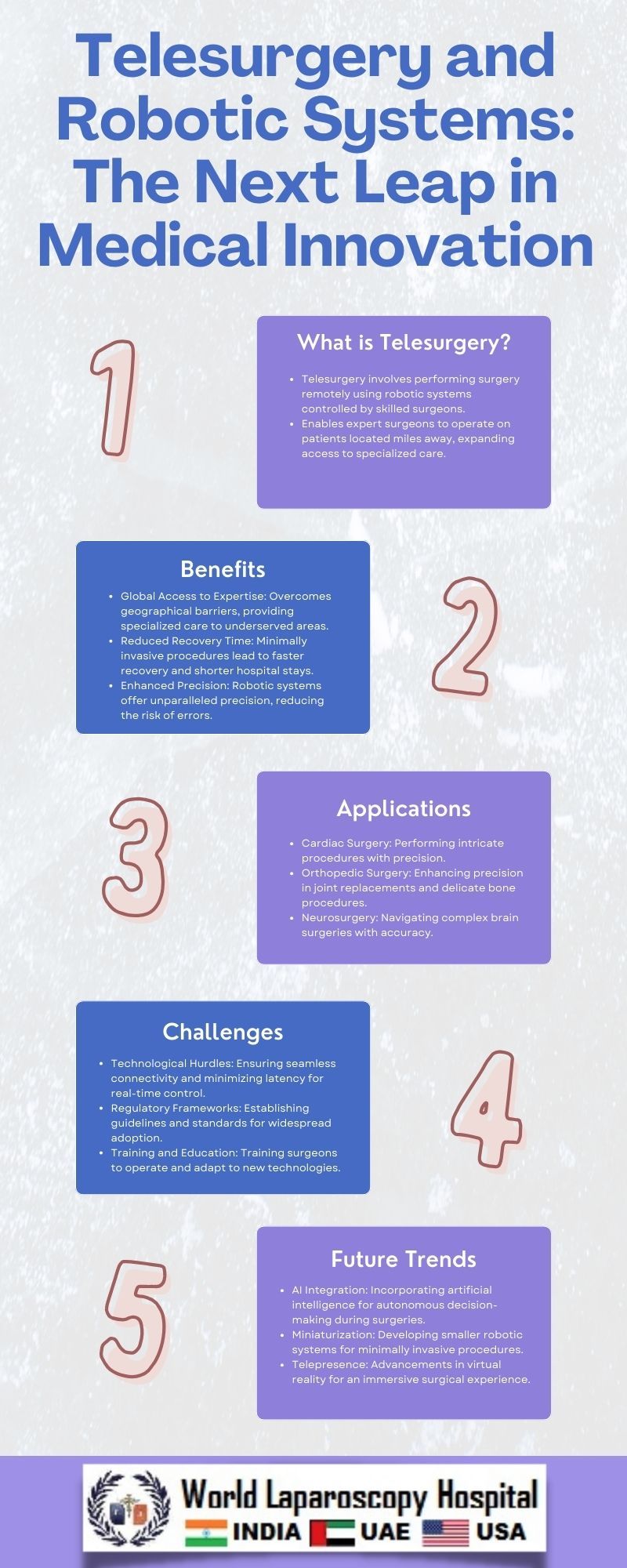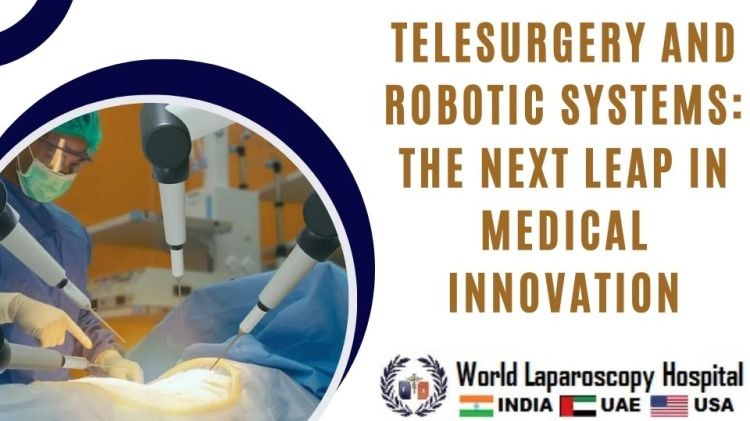Telesurgery and Robotic Systems: The Next Leap in Medical Innovation
Introduction:
In the ever-evolving landscape of medical innovation, telesurgery and robotic systems have emerged as transformative technologies, pushing the boundaries of what is possible in the field of surgery. This groundbreaking combination allows surgeons to perform intricate procedures from a remote location, offering a new dimension to healthcare accessibility, precision, and expertise. This article delves into the world of telesurgery, exploring its evolution, current capabilities, challenges, and the profound impact it has on global healthcare.

Evolution of Telesurgery:
The concept of telesurgery dates back to the late 20th century when technological advancements started paving the way for remote surgical interventions. The first documented telesurgery experiment took place in 2001 when a surgeon in New York successfully removed a gallbladder from a patient in France using a robotic system. Since then, continuous innovation in robotics, telecommunications, and virtual reality has propelled telesurgery to new heights.
Robotic Systems in Surgery:
Robotic systems, such as the da Vinci Surgical System, have played a pivotal role in enabling telesurgery. These sophisticated platforms consist of robotic arms controlled by a surgeon from a console. The robotic arms mimic the surgeon's hand movements with enhanced precision and dexterity, allowing for minimally invasive procedures. This technology has been widely adopted in various surgical disciplines, including urology, gynecology, and general surgery.
Advancements in Telecommunications:
The success of telesurgery heavily relies on seamless communication between the surgeon and the robotic system. Over the years, improvements in high-speed internet, low-latency communication networks, and the development of 5G technology have significantly enhanced the real-time transmission of data. These advancements are crucial for ensuring minimal delays and maximum accuracy during remote surgical procedures.
Current Capabilities and Applications:
Telesurgery has already demonstrated its efficacy in several medical scenarios, expanding the reach of surgical expertise and improving patient outcomes.
Global Accessibility to Expertise:
One of the primary advantages of telesurgery is its ability to bridge the gap in medical expertise across regions. Skilled surgeons can remotely assist and perform surgeries in underserved or remote areas, providing access to high-quality healthcare where it is often limited. This has the potential to revolutionize healthcare delivery in developing countries and rural communities.
Precision and Minimally Invasive Procedures:
Robotic systems in telesurgery enable surgeons to perform highly precise and minimally invasive procedures. The robotic arms can navigate tight spaces with greater accuracy than the human hand, leading to smaller incisions, reduced scarring, and faster recovery times for patients. This precision is particularly beneficial in delicate surgeries, such as neurosurgery and cardiac procedures.
Training and Skill Enhancement:
Telesurgery platforms offer a valuable tool for training and skill enhancement among surgeons. Novice surgeons can benefit from the guidance of experienced mentors who can remotely supervise and provide real-time feedback during procedures. This not only accelerates the learning curve but also ensures a standardized level of expertise across different medical institutions.
Challenges and Considerations:
While telesurgery holds immense promise, it is not without its challenges and ethical considerations.
Technical Challenges:
The success of telesurgery relies on advanced technology, and any technical glitches or interruptions in communication can have serious consequences. Ensuring a robust and reliable technological infrastructure is crucial to the safety and success of remote surgical procedures.
Legal and Regulatory Framework:
The legal and regulatory landscape for telesurgery is still evolving. Issues related to licensure, liability, and malpractice need to be addressed to establish a comprehensive framework that ensures patient safety and the accountability of healthcare providers involved in telesurgical procedures.
Ethical Considerations:
The ethical implications of telesurgery raise questions about patient consent, privacy, and the potential for depersonalization of medical care. Striking a balance between leveraging technology for improved healthcare and preserving the human touch in medicine is essential to address these ethical concerns.
Future Prospects and Innovations:
As technology continues to advance, the future of telesurgery holds even greater possibilities.
Integration of Artificial Intelligence:
The integration of artificial intelligence (AI) into telesurgery systems has the potential to enhance decision-making and surgical precision. AI algorithms can analyze vast amounts of medical data in real-time, providing surgeons with valuable insights and improving the overall efficiency of telesurgical procedures.
Virtual and Augmented Reality:
Virtual and augmented reality technologies are poised to play a significant role in telesurgery by providing surgeons with immersive visualization and enhanced spatial awareness. These technologies can create a virtual operating environment that closely mirrors the physical space, allowing surgeons to navigate complex anatomical structures with greater ease.
Telesurgery in Extreme Environments:
Telesurgery could find applications in extreme environments, such as space exploration or disaster-stricken areas, where access to medical expertise is limited. Remote surgical capabilities could be crucial in providing timely and life-saving interventions in challenging and remote settings.
Conclusion:
Telesurgery and robotic systems represent a paradigm shift in the field of surgery, offering unprecedented possibilities for remote, precise, and accessible medical interventions. While challenges and ethical considerations remain, ongoing technological advancements and the integration of emerging technologies like AI and virtual reality are poised to further revolutionize telesurgery. As the world continues to embrace these innovations, the promise of improved healthcare on a global scale becomes increasingly tangible.
